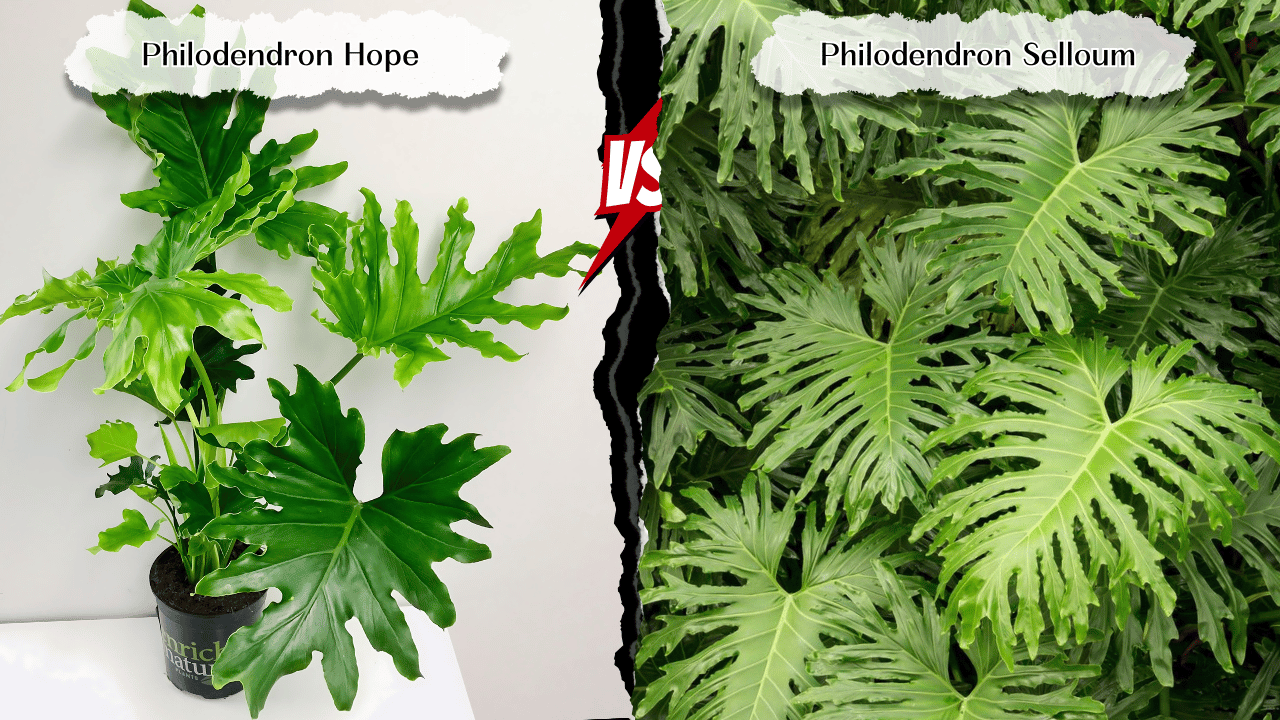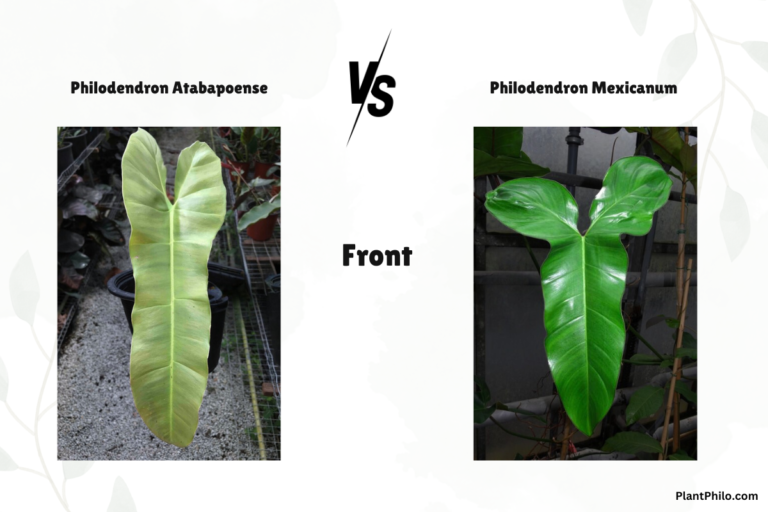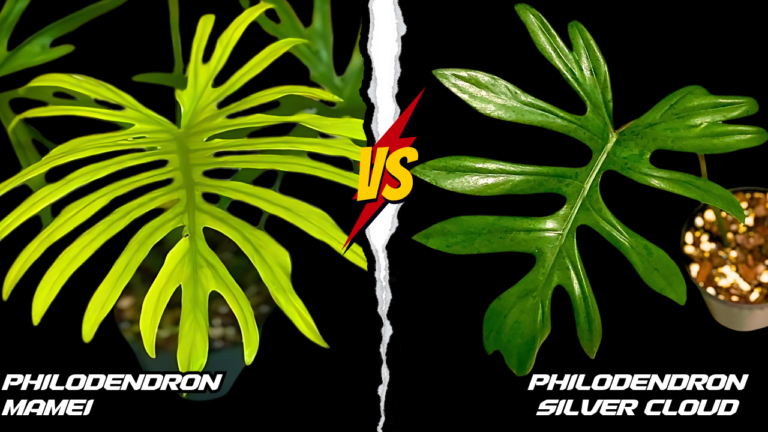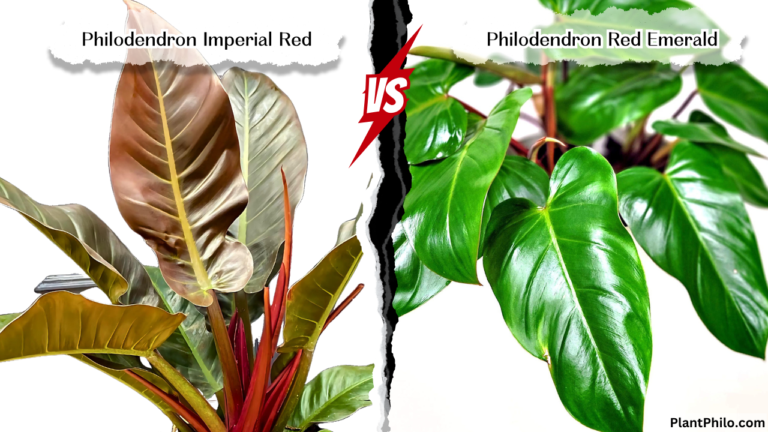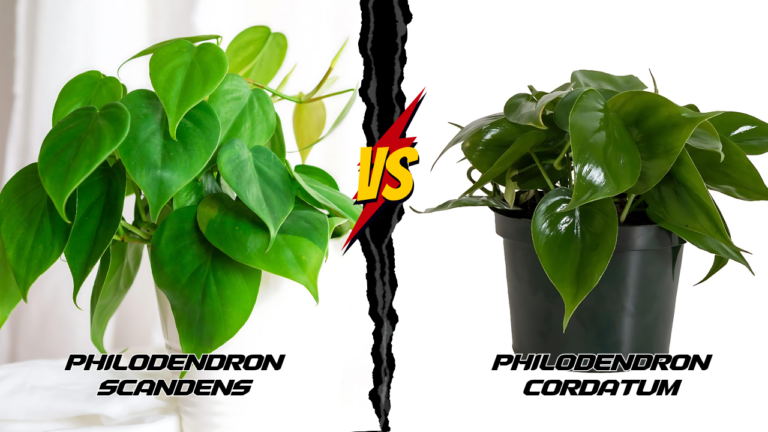Give Me 6 Minutes, I’ll Give You all About Philodendron Hope Vs Selloum
When it comes to choosing the perfect houseplant, understanding the difference between Philodendron Hope and Selloum is crucial for plant enthusiasts. While they may seem similar at first glance, these two varieties of philodendrons have distinct characteristics that can influence your decision based on your space, maintenance preferences, and aesthetic goals.
In this guide, we’ll break down the differences between these two popular philodendrons in a way that’s easy to understand, even if you’re new to plant care.
Both Philodendron Hope and Selloum bring a lush, tropical vibe to your indoor spaces, but subtle differences in their size, growth patterns, and care requirements can make one more suited to your needs than the other. Let’s dig into the details!
Difference between Philodendron Hope and Selloum
| Feature | Philodendron Hope | Philodendron Selloum |
| Botanical Name | Thaumatophyllum bipinnatifidum ‘Hope’ | Thaumatophyllum bipinnatifidum |
| Common Names | Hope Selloum, Tree Philodendron | Split-Leaf Philodendron, Horsehead Philodendron |
| Origin | Cultivar, origin linked to South America | South America (Brazil, Bolivia, Argentina, Paraguay) |
| Growth Habit | Self-heading, upright, tree-like but more compact | Self-heading, upright, tree-like |
| Leaf Shape & Size | Deeply lobed, bipinnatifid, up to 2-3 feet long | Deeply lobed, bipinnatifid, up to 3-5 feet long |
| Color | Glossy green | Glossy green |
| Light Requirements | Bright, indirect light; tolerates some shade | Bright, indirect light; tolerates some shade |
| Watering Needs | Water when top 2-3 inches of soil are dry | Water when top 2-3 inches of soil are dry |
| Humidity | Appreciates higher humidity, but tolerates average levels | Appreciates higher humidity, but tolerates average levels |
| Fertilizing | Balanced liquid fertilizer monthly during growing season | Balanced liquid fertilizer monthly during growing season |
| Common Pests & Diseases | Mealybugs, scale, spider mites | Mealybugs, scale, spider mites |
| Propagation | Stem cuttings or offsets (pups) | Stem cuttings or offsets (pups) |
| Toxicity | Toxic to pets and humans if ingested | Toxic to pets and humans if ingested |
| Petiole | Long, thick, often green | Long, thick, often green |
| Stem | Thick, trunk-like, forming a sturdy base | Thick, trunk-like, forming a sturdy base |
| New Leaf Color | Lighter green, maturing to deep green | Lighter green, maturing to deep green |
| Air Purifying | Moderate air purifying qualities | Moderate air purifying qualities |
| Overall Difficulty | Easy to care for | Easy to care for |
| Mature Size | Can reach 4-6 feet tall and wide | Can reach 6-10 feet tall and wide |
In-Depth Comparison
At a glance, the difference between Philodendron Hope and Selloum may not seem obvious. They both belong to the Philodendron bipinnatifidum species and are often mistaken for each other because of their similar leaf structures and tropical appearance.
However, the key differences lie in their growth habits, leaf size, and maintenance requirements. These small yet significant distinctions can affect how each plant fits into your living space or garden.
In simple terms, Philodendron Hope is a more compact, manageable variety, while Philodendron Selloum tends to grow much larger, with leaves that spread out significantly. So, if you’re short on space or prefer a more contained plant, Hope is often the better choice. On the flip side, if you want to make a bold statement with a large, striking plant, Selloum will deliver just that.
Leaf Structure and Growth Patterns: Subtle Variations
Let’s start with the leaves—the feature that most people notice first. The difference between Philodendron Hope and Selloum is quite clear when comparing their leaves up close.
Philodendron Hope has a compact growth habit, with leaves that tend to grow closer together. The leaves are deeply lobed and slightly ruffled, giving the plant a soft, textured appearance. Typically, Hope’s leaves reach about 1-2 feet in length. The shorter internodal spacing makes the plant look fuller and more shrub-like.
Philodendron Selloum, on the other hand, has much larger, deeply lobed leaves that can reach up to 3 feet or more in length. Its growth habit is more open, with broader leaves that create a sprawling, airy look. Selloum tends to spread out as it grows, often taking up a significant amount of horizontal space.
The leaf size and structure play a big role in deciding which plant fits better in your home or garden. If you’re looking for a plant that won’t take up too much space, the more compact Philodendron Hope is the way to go. In contrast, Selloum’s massive, showy leaves are perfect for filling larger areas or creating a statement piece in a room.
Size and Growth Speed: The Compact vs. The Giant
When choosing between these two varieties, it’s essential to consider their growth rate and ultimate size. A difference between Philodendron Hope and Selloum is that Selloum can grow much larger over time.
Philodendron Hope generally remains a more moderate size, growing up to 4-5 feet tall and wide when mature. Its relatively slower growth means it can stay more manageable indoors, making it ideal for people who don’t want to constantly prune or repot their plants. For someone living in a smaller apartment or home, Hope’s smaller size is a definite advantage.
Philodendron Selloum, by contrast, can grow to be a giant, reaching heights of 8-10 feet or more, with a similar width. This plant is known for its rapid growth under the right conditions, so if you’re not prepared for a plant that can quickly take over a room, you might want to reconsider. However, for large spaces or outdoor use in tropical climates, Selloum is the perfect candidate for creating a lush, dramatic backdrop.
It’s worth noting that Philodendron Selloum’s fast growth rate can be both a blessing and a curse. While it’s satisfying to see your plant grow rapidly, it also means you’ll need to keep an eye on its size and be prepared to move it or prune it as needed. On the other hand, Philodendron Hope’s more moderate growth makes it easier to maintain, even for someone with a busy schedule or less experience in plant care.
Care Requirements: Light, Water, and Soil
Though both plants are relatively easy to care for, the difference between Philodendron Hope and Selloum becomes more apparent in their care preferences.
Light
Both Philodendron Hope and Selloum thrive in bright, indirect light. Direct sunlight can scorch their leaves, causing damage that’s hard to reverse.
However, Selloum tends to be a bit more adaptable when it comes to lighting conditions. It can tolerate lower light situations better than Hope, though both will grow best with ample indirect light. If you have a slightly darker room, Selloum might be the better choice for maintaining healthy growth.
Water
The watering needs for both plants are similar, but due to its size, Selloum might require more water, especially in hotter climates or if grown outdoors. As a general rule, let the top inch or two of soil dry out before watering again.
Overwatering is a common problem with these philodendrons, leading to root rot. A good trick is to water thoroughly, allowing excess water to drain out completely. For both plants, always ensure they are in pots with drainage holes to avoid waterlogged soil.
Soil
Both plants prefer well-draining soil with a good balance of organic matter to retain some moisture without becoming soggy.
A mix of peat, perlite, and pine bark will work well for both Hope and Selloum. However, if you’re growing a larger Selloum, consider a heavier pot to anchor the plant, as it can become top-heavy with its larger leaves.
Fertilizer
In terms of fertilizer, both plants benefit from a balanced liquid fertilizer during the growing season (spring and summer), but Philodendron Selloum might require slightly more frequent feedings due to its faster growth rate. Regular feeding will promote larger, healthier leaves and keep the plant looking lush and vibrant.
Pruning and Maintenance
When it comes to maintenance, the difference between Philodendron Hope and Selloum is mostly about the amount of space you’re willing to dedicate and the time you have to prune. Both plants require occasional trimming to remove dead or yellowing leaves, but Selloum’s larger size and faster growth mean you’ll likely be pruning it more often.
Philodendron Hope‘s compact growth means it will stay neatly contained for longer periods without requiring much intervention. Occasional trimming will keep it looking tidy, but it won’t overwhelm your space. For someone who prefers a low-maintenance plant, Hope is often the better option.
Selloum, on the other hand, will need more regular attention to keep it in check, especially if it’s growing in a smaller indoor space. Left unchecked, Selloum can quickly outgrow its pot or spread it into nearby furniture. However, for gardeners who enjoy working with plants and don’t mind the occasional pruning session, Selloum’s rapid growth can be a rewarding challenge.
Common Pests and Diseases
Both Philodendron Hope and Selloum are relatively pest-resistant, but they are not entirely immune. The difference between Philodendron Hope and Selloum is minimal when it comes to pest issues, as they are both susceptible to the same types of insects, including spider mites, aphids, and mealybugs.
To prevent infestations, regularly inspect your plants for signs of pests, such as tiny webs, sticky residue on leaves, or small insects. If you spot any, wiping the leaves with a damp cloth or spraying the plant with a mild insecticidal soap can help eliminate the problem.
Another issue to watch for is root rot, which can occur if the plant is kept in overly wet soil. This is more common in Selloum due to its larger size and greater water needs, but both plants can suffer from it if overwatered. Good drainage is essential for preventing this problem.
Aesthetic Appeal and Versatility
The aesthetic appeal of Philodendron Hope and Selloum can vary based on personal preference and the space available. The difference between Philodendron Hope and Selloum lies in how they fill a room or garden.
Philodendron Hope brings a more compact, tidy appearance. It’s great for desks, shelves, or smaller corners where you want a pop of green without overwhelming the space. Hope’s delicate, ruffled leaves give it a softer, more understated look that can complement a variety of décor styles.
Philodendron Selloum, on the other hand, is a statement plant. With its large, dramatic leaves and sprawling growth, it’s perfect for making an impact in a living room or filling out a large, empty space. Selloum is particularly suited for use as an accent piece in homes with high ceilings or large windows, where its size and bold appearance can be fully appreciated.
Both plants can be grown outdoors in tropical or subtropical climates, but again, Selloum’s larger size makes it better suited for outdoor use in expansive gardens or patios. In contrast, Hope is more manageable and can be grown in smaller outdoor containers or garden beds.
Final Thoughts
The difference between Philodendron Hope and Selloum boils down to size, growth patterns, and maintenance needs. For those with limited space or a preference for low-maintenance plants, Philodendron Hope is the ideal choice. It stays compact and manageable while offering the same lush, tropical feel that people love in philodendrons.
Philodendron Selloum, on the other hand, is for those who want to make a bold statement with a larger, fast-growing plant. It requires more space and attention but offers dramatic, large leaves that can fill a room or outdoor area with its presence.
Whether you choose Hope or Selloum, both plants are excellent options for bringing greenery and a touch of the tropics into your home or garden. By understanding the differences between these two philodendrons, you can make an informed decision and enjoy the benefits of these beautiful plants for years to come.
Is the Philodendron Hope the same as the Selloum?
Technically, no. The Hope is a cultivar of the Selloum, meaning it’s a cultivated variety with slightly different characteristics.
Which plant is better for small spaces?
The Philodendron Hope, due to its more compact size.
Which plant grows faster?
The Philodendron Selloum generally grows faster than the Hope.
Can I prune these plants?
Yes, you can prune both to manage their size and shape.
Do these plants flower?
They rarely flower indoors.
What type of soil is best?
A well-draining potting mix rich in organic matter.
How often should I repot?
Repot every 2-3 years or when roots become overcrowded.
Can I grow them outdoors?
Yes, in warm climates, but provide protection from harsh sunlight.
Why are the leaves on my plant turning yellow?
This could indicate overwatering, underwatering, or nutrient deficiencies.
What’s the difference in price between the Hope and Selloum?
The Philodendron Hope, being a cultivar, is often slightly more expensive than the standard Selloum.

